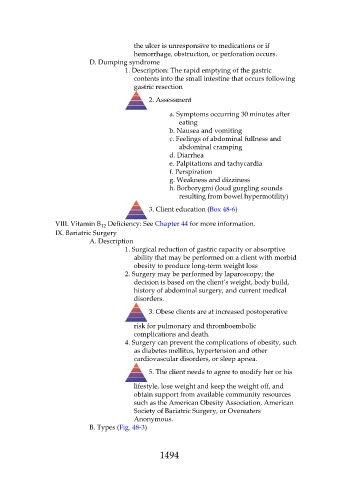Page 1494 - Saunders Comprehensive Review For NCLEX-RN
P. 1494
the ulcer is unresponsive to medications or if
hemorrhage, obstruction, or perforation occurs.
D. Dumping syndrome
1. Description: The rapid emptying of the gastric
contents into the small intestine that occurs following
gastric resection
2. Assessment
a. Symptoms occurring 30 minutes after
eating
b. Nausea and vomiting
c. Feelings of abdominal fullness and
abdominal cramping
d. Diarrhea
e. Palpitations and tachycardia
f. Perspiration
g. Weakness and dizziness
h. Borborygmi (loud gurgling sounds
resulting from bowel hypermotility)
3. Client education (Box 48-6)
VIII. Vitamin B Deficiency: See Chapter 44 for more information.
12
IX. Bariatric Surgery
A. Description
1. Surgical reduction of gastric capacity or absorptive
ability that may be performed on a client with morbid
obesity to produce long-term weight loss
2. Surgery may be performed by laparoscopy; the
decision is based on the client’s weight, body build,
history of abdominal surgery, and current medical
disorders.
3. Obese clients are at increased postoperative
risk for pulmonary and thromboembolic
complications and death.
4. Surgery can prevent the complications of obesity, such
as diabetes mellitus, hypertension and other
cardiovascular disorders, or sleep apnea.
5. The client needs to agree to modify her or his
lifestyle, lose weight and keep the weight off, and
obtain support from available community resources
such as the American Obesity Association, American
Society of Bariatric Surgery, or Overeaters
Anonymous.
B. Types (Fig. 48-3)
1494

